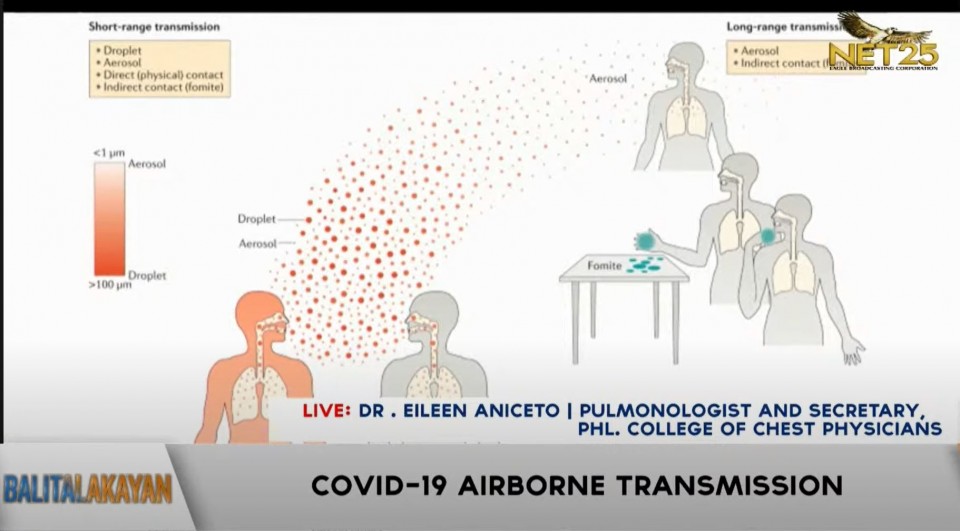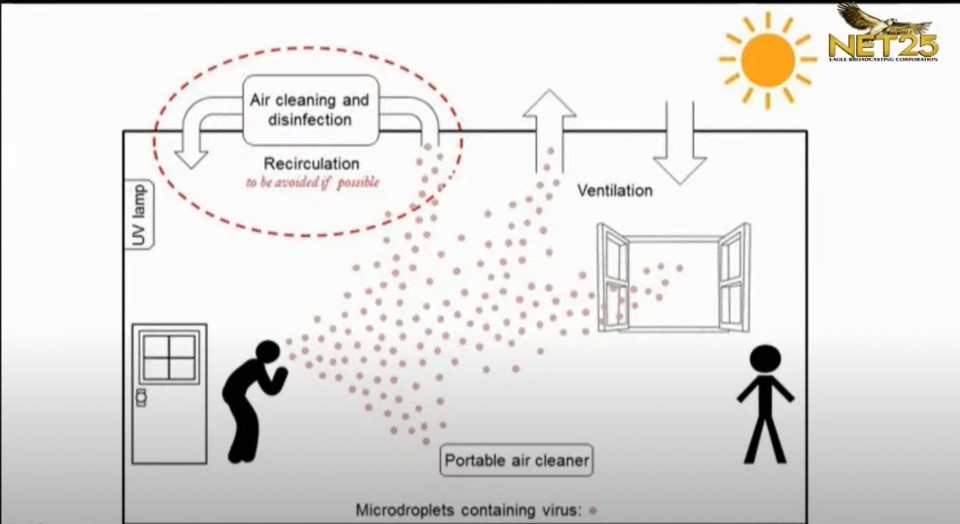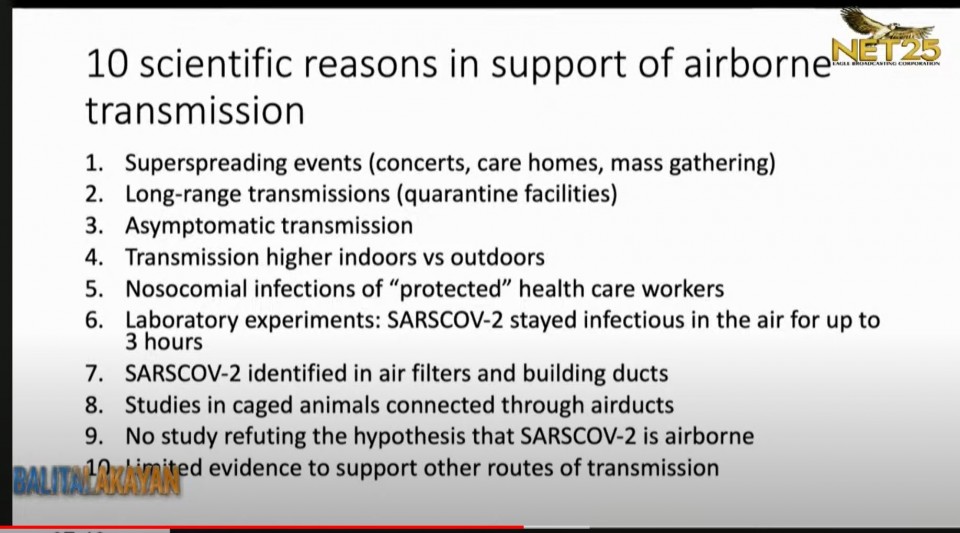Importance of increased ventilation, stricter observance of health protocols cited by pulmonologist, Dr Eileen Aniceto in “Balitalakayan” interview
(Eagle News) – The public should take extra precautions to protect themselves from COVID-19 after scientific evidence showing that COVID-19 is now not just spread through droplets, close contact, or even by touching infected surface, but through the air.
Airborne transmission of COVID-19 means that the virus can be spread in farther distances (more than six feet) and can stay in the air for longer periods of time, said pulmonologist, Dr. Eileen Aniceto, secretary of the Philippine College of Chest Physicians, who manages the emergency medicine and outpatient department at the Lung Center of the Philippines.
“Evidence is showing that there is airborne transmission,” said Dr. Aniceto, in an interview with Eagle News Service’s “Balitalakayan” on NET 25 Wednesday, April 21.
This makes the challenge of preventing COVID-19 transmission more difficult.
“Ang nakakalimutan na intervention is ventilation,” Dr. Aniceto noted.
-How aerosolized particles can further COVID transmission –
She explained that the COVID-19 virus can be spread through aerosolized infected particles, which are less than 1 micron in diameter, a size too small that it is spread faster, and farther, and even stays in the air longer.
This is unlike droplets, which are almost visible to eye, because they are larger at more than 1 micron in diameter.
One micron is equivalent to .001 millimeter. Aerosolized particles are less than this in size, thus the danger.

When an infected person sneezes, he or she spreads infectious particles through droplets and through infectious aerosolized particles (less than 1 micron) that are infected. Whereas droplets from an infectious person who sneeze can land on nearby surfaces because they are bigger and heavier, aerosolized infectious particles from that action of sneezing spread farther at more than six feet, and even circulates in the air. Because these ultra-small infectious aerosol particles are much lighter, they just spread farther and circulate in the air, and thus could be inhaled by another person.
“These particles are just suspended in the air. Mas matagal na nag-i-stay sa hangin (They stay longer in the air),” noted Dr. Aniceto in the interview.
This is where good ventilation – opening windows for better airflow – helps.
An airconditioning system that filters or cleans the air, and portable air cleaner that sucks the air inside a room, and cleans it, also help, Dr. Aniceto said. It is also good to have UV disinfection once a day to kill the viruses in the air.

In the interview, Dr. Aniceto explained that the aerosolized infected particles that just circulate in the air in an enclosed space or room also eventually land on surfaces such as tables, desktops, computers, cellphones, chairs, to name a few, and infect those who will touch these surfaces.
“If they eventually land on surfaces, magkakaroon tayo ng (there would be) fomite on surfaces,” she said.
In medicine, fomites are inanimate objects or materials that can carry and spread disease and infectious agents.
Dr. Aniceto said that aerosolized infectious particles also spread the virus especially in mass gatherings – both in open and closed spaces. This is also because of the nature of these aerosol particles that can travel farther and can stay suspended in the air longer.

“Ito yung mga evidence proving that it’s airborne. They tested the air. This is the first time na nakakuha ng ganyan. Transmission in concerts, both in open or closed settings,” she said.
“May kumpul-kumpol na kaso (There is clustering of cases) coming from mass gatherings. Sa quarantine facilities, may hawaan pa rin (In quarantine facilities, there is also infection),” she said in the Balitalakayan interview.
“They actually tested air filters and building ducts and they were able to isolate the virus there,” she said citing a study involving infected caged animals in different areas connected through airducts.
Because of this evidence of airborne transmission of the virus, people should be more obsessive compulsive with regards to hygiene, she said. They should observe minimum health protocols more strictly and more conscientiously, conscious of the airborne transmissibility of the virus.
-Importance of understanding how COVID is transmitted-
For example, she said, inside a room, a person thinking that he is alone, removes his mask, and then sneezes. If that person has COVID-19 and doesn’t know it, those infectious droplets land on surfaces, and the aerosolized infectious particles travel in the air. Even if he leaves the room, these infectious aerosol particles can be inhaled by other persons who will subsequently enter the room if they don’t wear masks.
These can also enter the eye if they don’t wear face shields. The fomites on objects due to the infections particles that eventually land on surfaces can also infect people who touch them, if they don’t wash their hands before they touch their nose, mouth or eyes. Here the importance of frequent and proper handwashing, and sanitation or disinfection of surfaces come in.
A common mistake is also to remove masks when a person thinks that it is safe to do so because he or she is alone in the room. It is important before doing so to disinfect surfaces, and to clean the air, or open windows for proper ventilation.
“Same lang ang health protocols, tighter lang. Kailangan ipaintindi kung paano nakakahawa ang Sars-Cov-2,” Dr. Aniceto said referring to the virus that causes COVID-19.
-Problem of COVID-19 transmission compounded by asymptomatic cases-
The problem is compounded with the increasing number of asymptomatic cases of COVID-19. These persons, even before that they know or suspect that they have the virus, can already spread it around in their work area, and among their family members who are likewise unsuspecting because they don’t show symptoms. They touch surfaces, touch their loved ones, and also spread virus through the air.
“Unfortunately, meron na tayong tinatawag na asymptomatic transmission. Ibig sabihin, wala pang nararamdaman yung tao, nakakahawa na siya. (Unfortunately, we have what we call asymptomatic transmission. This means, the person can already infect others even before he feels any symptoms) That’s another evidence for airborne transmission. Hindi naman siya umuubo kaya wala siyang droplets. Pero nakakahawa na siya (He does not cough, so there are no droplets, but he can already be infectious)” Dr. Aniceto explained in the Balitalakayan interview.
She said that two days before the onset of symptoms, the asymptomatic person can already infect others with COVID-19.
“So two days siyang nakakahawa, bago siya magkaroon ng sore throat, tapos mag-te-test, ay COVID. (That asymptomatic person has been spreading the virus two days before he experiences symptoms of sore throat, and when he undergoes testing, it’s COVID) Wala na, exposed na everybody (It’s too late. Everybody has been exposed),”
Those with comorbidities and the elderly, who usually just stay inside their homes are the people most vulnerable to this.
“There are some of the evidence that show us that it is indeed airborne already. So there is consistent and strong evidence that SarsCov2 is spread also by airborne, also by droplet, also by contact, and also by fomite. So these are all means of transmission,” Dr. Aniceto said.
She also pointed out that hospitals are already full and overwhelmed; thus, it would be best for the public to be more careful and conscientious, and to strictly follow health protocols so they and their loved ones won’t get sick.
“So huwag tayong mag-shortcut (Let’s not do shortcuts). Let’s do what is necessary,” she said referring to the strict observance of health protocols. “This is also for your own protection, and for the protection of your family,” she added.







